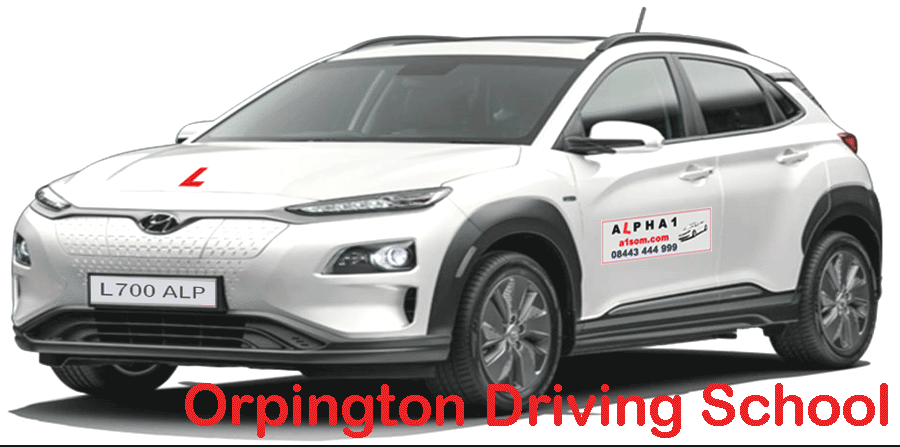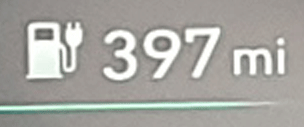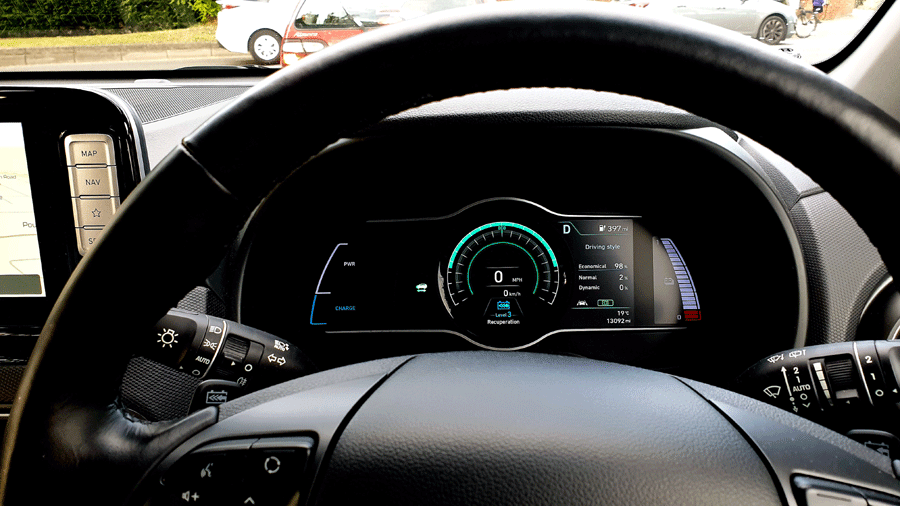
Driving Electric Cars and how to get the best mileage - seriously 'Eco-friendly' transport

Mileage at the start of 18th September 2020
though Hyundai claim only 297 miles range!
How to get the best from your electric car
Contact us for further information or training for Eco-friendly, Economical driving that can save you money and preserve the environment
Hyundai giving the estimated mileage for the Kona Electric (2020) car as 297 miles per full charge, it is possible to significantly get more miles per charge. The image below is a picture of the dash on my car showing a mileage available of 397 miles; it has reached 403 on one occasion!
Why is this?
I am no techie but my understanding is that the range figure is calculated on a product of the available battery power remaining, and the average usage rate (miles/Kwh). This means that, since the quantity of electricity is roughly a set for a given battery (Mine is 64kWh), then the range is dependent on the rate of usage. Therefore the more eco-friendly your driving style is, the more miles/charge you will achieve.The factors for achieving maximum mileage from an electric car are similar to the internal combustion engine cars but some have more marked effect: (Click for fuller explanation)
| Slowing | Use of maximum regeneration mode and early, gentle reactions to changing road conditions |
| Acceleration | Light and gentle - only when necessary |
| Temperature | Cold ambient temperature reduces mileage |
| Road surface | Irregularities and potholes reduce mileage |
| Cruise control | Increases mileage |
| Tyres | Under inflated tyres reduce mileage |
| Steering | All steering effective acts as a brake, ‘small steering’ increases mileage |
| Speed | More relevant for electric over 55mph reduces mileage |
| Weight carried | The greater the weight, the more energy is required |
| Route selected | Uphill stretches require higher energy – town is better than motorway for electric |

Slowing:
The highest use of electric (or fuel in a normal car) is during acceleration. The key to maximising range is not slowing more than necessary and therefore not have to speed back up. The art is to this is to react earlier to driving and traffic conditions in order to keep your vehicle moving at a faster overall speed. An example of this would be approaching traffic lights on red:The average driver will see this situation later, and then keep their foot on the gas pedal and then brake firmly to stop. Once the lights change, an average driver will accelerate harshly away.
A better driver will see the necessity to slow/stop earlier and (after the mirror check) slow earlier at a rate proportional to the distance from the lights. (In an electric car with a setting of maximum regeneration (taking the foot off the gas pedal slows the car significantly as the batteries are re-charged at maximum rate). The expert driver will therefore slowdown less than the average, and often not stop. This is significant as it takes considerably more energy to overcome inertia than to continue on the move. It has been said that it takes the same fuel (and therefore pollution) to accelerate from 0 to 1 as to go from 2 to 10 mph. This means, just by not stopping cars will save a significant amount of fuel and pollution.
Back to top
Acceleration:
The highest use of fuel (and therefore cause of pollution) is during acceleration. Gentle, but positive acceleration, gives the best results, but much more important is not having to accelerate, because the car has not been slowed down. (See Slowing)Back to top
Temperature:
All cars will give less mileage in cold temperatures as the air through which they travel is more viscous. Electric cars are effected also by the temperature of the batteries which perform less will when cold.Back to top
Road surface:
All irregularities need energy to overcome – the bigger the effect on the car, the more the effect on mileage. The key to dealing effectively with rough roads (as most appear to be nowadays) is to see the irregularity early and to gently (after the mirror check) adjust the course to miss the rough parts as much as possible.Back to top
Cruise control
This is particularly effective on motorways etc, but can be applied on other roads where traffic is not constantly changing speed. Cruise is effective because it is better at keeping sped constant without the constant changes in the driver’s foot on the gas pedal will change pressure causing unnecessary accelerations.Back to top
Tyres
Using lumpy (eg of road or damaged) or under-inflated tyres will markedly reduce mileage. Do remember that tyres are effected by temperature – check whilst cold (before use) and check if the ambient temperature changes significantly. A change of 10º Celsius will significantly effect tyre pressure.Back to top
Steering
Technically all steering is effectively controlled skidding and involves use of energy. The less steering is used, the more eco-friendly will be the drive in relation to gas usage, pollution and tyre wear.Back to top
Speed
Electric cars, in my experience, are effected more than standard engine cars by higher speeds. The average car apparently is most efficient at about 55mph. This figure seems to work well with electric cars also but I have no hard data, or research to support this. With the hybrid car I had before the full electric vehicle, (on a motorway journey of 40 miles each day) at 70 mph I saw mpg in the region of 60 mpg whereas that figure rose to 75 mpg (80mpg is hot weather) at a constant 55 mph.Back to top
Weight carried
Clearly it will take more energy to move a heavier load.Back to top
Route selected
Stop-start driving effects a normally engine car more than electric. Electric cars will give a better range taking the shortest routes, often through towns, rather than the faster motorway/bypass roads.Back to top

